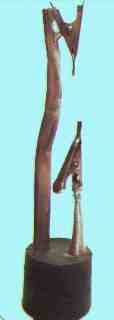 Young
Edison
Young
Edison Young
Edison
Young
EdisonNote: This activity requires the use of a specially built piece of equipment. This equipment is illustrated and described below.
 The custom equipment is illustrated at
the left. It consists of a wood base into which is plugged a solid copper
bar (rod). This solid copper bar goes through a rubber stopper and has a
small alligator clip soldered to its tapered end.
The custom equipment is illustrated at
the left. It consists of a wood base into which is plugged a solid copper
bar (rod). This solid copper bar goes through a rubber stopper and has a
small alligator clip soldered to its tapered end.
Through the other hole in the rubber stopper goes a length of copper tubing. At the top of this tubing is soldered another aligator clip. At the other end of the tubing is a small brass needle valve. A hose connector is fastened on to the brass valve.
A pyrex test tube fits over the whole thing and plugs onto the rubber stopper for an air tight fit.
Filaments to be tested are held between the two clips.

To the right is a close up of the two clips.
Once the filament sample is carefully clamped between the two clips, the whole thing is covered with the large test tube.
The air inside the test tube can be pumped out through the copper tubing so that the filaments may be tested under a partial vacuum. Stopcock grease may be used to seal any leaks around the stopper.
 To the left is a close up of the brass
needle valve and hose connector. You will notice that the copper tubing
has been bent and crimped for clearance reasons. The tubing will still let
air flow.
To the left is a close up of the brass
needle valve and hose connector. You will notice that the copper tubing
has been bent and crimped for clearance reasons. The tubing will still let
air flow.
A vacuum pump is attached to the hose connector to evacuate the chamber around the filament.
Electrical leads are clipped to the solid copper bar and to the copper tubing so that current will flow through the filament sample.
Power supply: Your instructor will provide the power supply to be used when testing your filament samples. If nothing else is available, a 12 volt automobile battery charger (trickle type) will work nicely. You will want to keep the voltages used under 20 volts. It is best if you can vary and control the voltage from 0 up to the 20 volt limit. You might want to wear sun glasses when conducting the filament tests as the filaments can get rather bright.
Filament samples: This equipment was originally designed and made to test the feasability of using ultrafine pencil leads (graphite) as a bulb filament. These are always available and make a very bright light. Speaker wire which has been untwisted into its fine filaments makes a very good sample to test. Part of your task in this activity is to come up with additional materials as samples for filaments. You may want to check references to duplicate Thomas Edison's carbonized thread filament. It must be remembered that the samples need to be very fine. Try to come up with from 6 to 10 filament materials to be tested.
What makes a good filament?: This is the heart of the Young Edison activity. Your research team must decide upon the following issues before completing this activity:
Your conclusions: Your conclusions as to what makes the best filament material must be based entirely upon the criteria your team established and the data you collected. Be certain in your conclusions to state the reasons why your team feels the material selected would make the best filament. All of this activity must be written up in proper scientific lab format. One write up with all team members' names at the top should be turned in at the completion of the activity.
